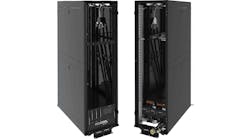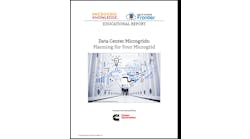Vertiv and DDC Invest to Expand High-Density AI, HPC Data Center Capabilities
In a dynamic era marked by rapid technological advancements, two major players in the data center infrastructure market—DDC Solutions and Vertiv—have announced significant initiatives aimed at meeting the surging demand driven by Artificial Intelligence (AI) and High-Performance Computing (HPC) uptake.
These developments reflect a broader industry movement towards enhancing the efficiency and density of data centers to cater to modern computing needs.
DDC Solutions Expands Leadership to Tackle Cooling Challenges
DDC Solutions, previously known as DDC Cabinet Technology, is a leader in cooling innovation for data centers. Recognizing the growing needs of the industry, the company has made strategic additions to its leadership team to enhance its engineering capabilities. This move follows recent funding by Cequal III and Thompson Street Capital, which positions DDC for expansion and growth in a rapidly evolving industry.
DDC announced the appointment of Paul Bartlett as Chief Operating Officer and Tom Demitras as Vice President of Engineering.
Both men bring decades of experience in their respective fields and are tasked with scaling DDC’s design and manufacturing capabilities. Their expertise is intended to address the pressing issue of cooling efficiency in data center, a critical task, as AI and HPC continue to push the limits of data center cooling and energy demand.
Bartlett, who has extensive experience in aerospace engineering and operations, has already implemented new manufacturing methods at DDC.
His work includes using advanced CAD techniques with integrated 3D modeling for DDC’s Computer Aided Manufacturing facilities.
This seamless integration of engineering disciplines not only guarantees optimal cabinet performance but also ensures high manufacturing efficiency and shorter lead times.
As Bartlett said:
“Our team is chartered with building data center solutions that enable unprecedented density and efficiency to support the industry's transition to 100 kilowatts per cabinet air-cooled, a critical step towards achieving the industry's drive for a megawatt per cabinet. It will take air and liquid to achieve these industry advancements, and we are up for the challenge."
The advancements driven by Bartlett are part of DDC’s broader initiative to enhance the production of its patented Dynamic Density Control technology, which combines traditional air cooling with emerging liquid cooling to create solutions ready for the future demands of data centers.
Demitras, with his expertise in mechanical and electrical systems, as well as software and hardware development, brings a deep understanding of data center needs.
His background in heavy fabrication and industry standards allows him to contribute to designing high-quality, custom-built cooling cabinets for some of the world’s largest data centers.
Demitras' work aims to ensure that DDC’s solutions are compliant with ISO, UL, and NEMA standards, which is crucial in building efficient and reliable data center infrastructure.
Vertiv Expands Manufacturing Footprint to Support Growing AI Demand
In this same timeframe, Vertiv, a key player in digital infrastructure solutions, announced an expansion of its manufacturing operations in North America.
The expansion comes in response to the increasing global demand for AI, which is driving the need for more integrated and efficient data center solutions.
Vertiv’s new facility in Pelzer, South Carolina, adds 215,000 square feet of manufacturing space and is expected to create up to 300 skilled jobs.
This facility will produce a range of Vertiv infrastructure solutions, including integrated modular systems, modular power solutions, and other technologies specifically designed for data centers.
The prefabricated nature of the Vertiv solutions reduces the amount of on-site labor required to deploy, speeding up the construction and deployment of new data centers, an increasingly important aspect as data center demand grows.
According to Vertiv CEO Giordano (Gio) Albertazzi:
“Increasing manufacturing capacity is critical to meeting the needs of our customers, and the Vertiv Pelzer operations are central to that mission for our Americas and global operations.”
Vertiv has also focused on expanding its manufacturing footprint not only in the United States but also in other strategic locations, including Mexico, Slovakia, the United Arab Emirates, Ireland, and Northern Ireland.
This global expansion strategy is designed to support increased capacity in their infrastructure solutions, switchgear, and busbar businesses, allowing the company to meet constantly growing demand.
The Push for Higher Density and Efficiency in Data Centers
The expansions by DDC Solutions and Vertiv highlight a significant trend in the data center industry: the need to adapt infrastructure to handle higher densities and greater efficiency.
As AI and HPC applications continue to proliferate, data centers are being pushed to their limits, necessitating new cooling solutions, power innovations, and more efficient deployment methods.
The shift towards higher power densities, such as the rapid moves to support 100 kilowatts per cabinet, or even the megawatt per cabinet that a number of speakers at our recent Data Center Frontier Data Center Trends conference discussed, is driving innovation in cooling technologies.
DDC's hybrid cooling approach, which integrates both air and liquid cooling, represents a flexible solution that can meet today’s demands while also preparing for future shifts towards liquid-to-the-chip cooling.
At the same time, Vertiv’s integrated modular solutions offer a practical response to the rapid growth in data needs. By manufacturing prefabricated systems that are fully tested before reaching the customer site, Vertiv is providing a way to significantly reduce deployment time, a crucial requirement given the rapid changes in data center design and construction.
Implications for the Future of Data Centers
The initiatives by DDC Solutions and Vertiv are representative of the cooling innovation, modular infrastructure, and strategic leadership changes that are preparing data centers for the future.
Cooling solutions, like those developed by DDC, are becoming necessary due to the heat generated by the increasingly dense server cabinets needed to meet the demands of AI, while Vertiv’s expanded production of modular infrastructure solutions offers a path for quick and scalable data center deployment.
With AI and HPC pushing the boundaries of what data centers can handle, DDC and Vertiv are positioning themselves as key players in enabling the next generation of data center capabilities.
The combination of leadership talent, strategic manufacturing expansion, and innovative cooling and infrastructure solutions points towards a future where data centers are more capable, efficient, and ready to handle the massive computational needs of tomorrow.






